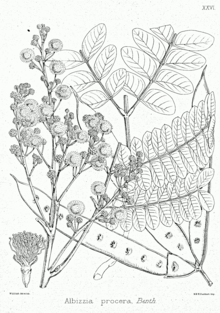
Abies procera, the noble fir, also called red fir and Christmas tree, is a species of fir native to the Cascade Range and Pacific Coast Ranges of the northwestern Pacific Coast of the United States. It occurs at altitudes of 300–1,500 meters (980–4,920 ft).

Dysoxylum is a flowering plant genus of trees and shrubs from the mahogany family, Meliaceae.

Allocasuarina torulosa, the rose she-oak or forest oak, is a tree which grows in sub-rainforest of Queensland and New South Wales, Australia. There, it is typically found on coastal footslopes, hills, and plains. Originally described as Casuarina torulosa by William Aiton, it was moved to its current genus in 1982 by Australian botanist Lawrie Johnson. It is the type species of the genus Allocasuarina.
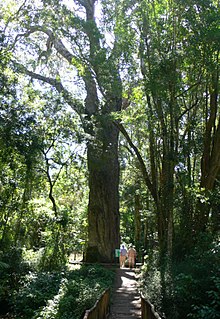
Afrocarpus falcatus is a species of tree in the family Podocarpaceae. It is native to the montane forests of southern Africa, where it is distributed in Malawi, Mozambique, South Africa, and Eswatini. Common names include common yellowwood, bastard yellowwood, outeniqua yellowwood, African pine tree, weeping yew, Afrikaans: outeniekwageelhout, kalander, Sotho: mogôbagôba, Xhosa: umkhoba and Zulu: umsonti. It is widespread, in some areas abundant, and not considered threatened, but it is a protected tree in South Africa. It is grown as an ornamental tree, especially in South Africa, and occasionally abroad.

Pithecellobium dulce, also known as Samania saman, and commonly known as Manila tamarind, Madras thorn, Monkeypod Tree or camachile, is a species of flowering plant in the pea family, Fabaceae, that is native to the Pacific Coast and adjacent highlands of Mexico, Central America, and northern South America. It is also sometimes known as monkeypod, but that name is also used for several other plants, including Samanea saman. It is an introduced species and extensively naturalized in the Caribbean and Florida, as well as the Philippines and Guam via the Manila galleons. It has also been introduced to Thailand and South Asia, It is considered an invasive species in Hawaii.

Albizia lebbeck is a species of Albizia, native to Indomalaya, New Guinea and Northern Australia and widely cultivated and naturalised in other tropical and subtropical regions. English names for it include lebbeck, lebbek tree, flea tree, frywood, koko and woman's tongue tree. The latter name is a play on the sound the seeds make as they rattle inside the pods. Being one of the most widespread and common species of Albizia worldwide, it is often simply called siris, though this name may refer to any locally common member of the genus.
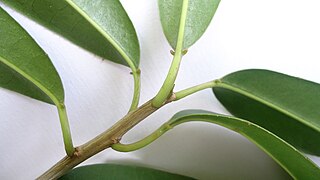
Sapium glandulosum is a species of tree in the family Euphorbiaceae. It is native to the Neotropics from Mexico and the Caribbean south to Argentina, and it has been cultivated elsewhere. It is the most common Sapium species. Its common names include gumtree, milktree, leche de olivo, and olivo macho.

Albizia acle is a species of flowering plant in the family Fabaceae. It is commonly known as akle, acle, or East Indian walnut, is a medium-sized tree grown for its strong wood used mainly in the construction of houses and furnitures.

Barringtonia racemosa is a tree in the family Lecythidaceae. It is found in coastal swamp forests and on the edges of estuaries in the Indian Ocean, starting at the east coast of Mozambique and KwaZulu-Natal to Madagascar, India, Sri Lanka, Malaysia, Maldives, Thailand, Laos, southern China, northern Australia, coastal Taiwan, the Ryukyu Islands and many Polynesian islands.

Syzygium nervosum is a species of tree native to tropical Asia and Australia, extending as far north as Guangdong and Guangxi in China and as far south as the Northern Territory of Australia. It was previously known as Cleistocalyx operculatus and also known as C. nervosum(DC.) Kosterm., and Eugenia operculataRoxb., 1832. It is a medium-sized tree of about 10 meters in height with pale brown bark and dull green leaves.
Cinnamomum mercadoi (kalingag) is a small tree, about 6 to 10 metres high, with a thick, aromatic bark. The plant part of the family Lauraceae, which contains about 45 genera and 2000-2500 species, and is related to the culinary cinnamon, sassafras, and bay tree. The plant is indigenous to the Philippines, where it grows best in forests at low and medium altitudes that sometimes ascend to 2,000 metres (6,600 ft). C. mercadoi is unusual in the cinnamon family in that its essential oil consists large amounts of safrol, whereas other oils of cinnamon contain cinnamaldehyde. It is currently listed in the International Union for Conservation of Nature (IUCN) Red List as "vulnerable" due to the overharvesting and the continuous loss of the Philippine forests.

Albizia odoratissima, a member of the family Fabaceae, is a fast-growing, deciduous tree reaching 15 to 25 m in height, a diameter of 120–150 cm (47–59 in), and native to large parts of India, Bangladesh, Bhutan, Nepal, Myanmar, Laos, Thailand, Vietnam, Sri Lanka and China. It is one of the top nitrogen-fixing trees.

Albizia canescens, commonly known as Belmont siris, is a species of Albizia, endemic to Northern Australia.

Dillenia alata, commonly known as red beech, golden guinea flower or golden guinea tree, is a tree in the Dilleniaceae family, found in tropical forests of the Moluccas, New Guinea, and northern Australia.
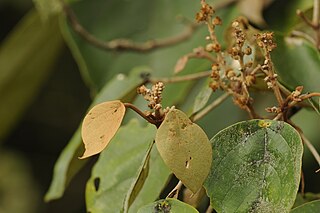
Mallotus tetracoccus, also known as the rusty kamala, is a species of flowering plant in the family Euphorbiaceae. It is a tree species found in parts of south Asia, typically occurring in the edges of tropical wet evergreen and semi-evergreen forests.

Lysiphyllum cunninghamii is a species of plant in the family Fabaceae. It is native to northern Australia where it occurs from Western Australia through the Northern Territory to Queensland.

Syzygium claviflorum is a tree in the Myrtaceae family. It is native to the north of the Australian continent and in tropical and subtropical Asia. It is used for timber, as fuel, as human and cattle food, and for dye. Stunted specimens can be found on the top of the plateau of Bokor National Park, Cambodia.
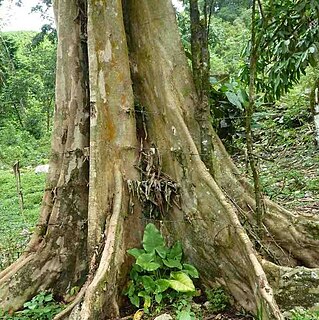
Licania platypus, also known as sun sapote, sansapote, sonzapote, sunzapote, sungano, zapote cabelludo, sapote, sangre, zapote amarillo, zapote borracho, zapote cabello, zapote de mico, zapote de mono, mesonsapote, mezonzapote, cabeza de mico, caca de nino, sonza, sunza, zunza, chaute jolobob, urraco, chupa, and monkey apple, is a flowering tree in the family Chrysobalanaceae.
Calamus erectus, also known as viagra palm and locally as tynriew, tara, and zhi li sheng teng, is a flowering shrub in the family Arecaceae. The specific epithet (erectus) refers to the plant's habit of growing straight rather than creeping or climbing like many species of the genus Calamus. Adi tribes in Arunachal Pradesh in India called it Tara.

Litsea garciae, also known as engkala, kalangkala, kangkala, medang, pangalaban, ta'ang, malai, wuru lilin, kelimah, bua talal, kelime, kelimie, bua' vengolobon, wi lahal, kelima, mali, beva' mali, kayu mali, malei, pengalaban, pengolaban, kupa, pipi, bagnolo, bangulo, lan yu mu jiang zi, lan yu mu, buah tebuluh, tebulus, pong labon, and Borneo avocado, is a flowering tree in the family Lauraceae.
